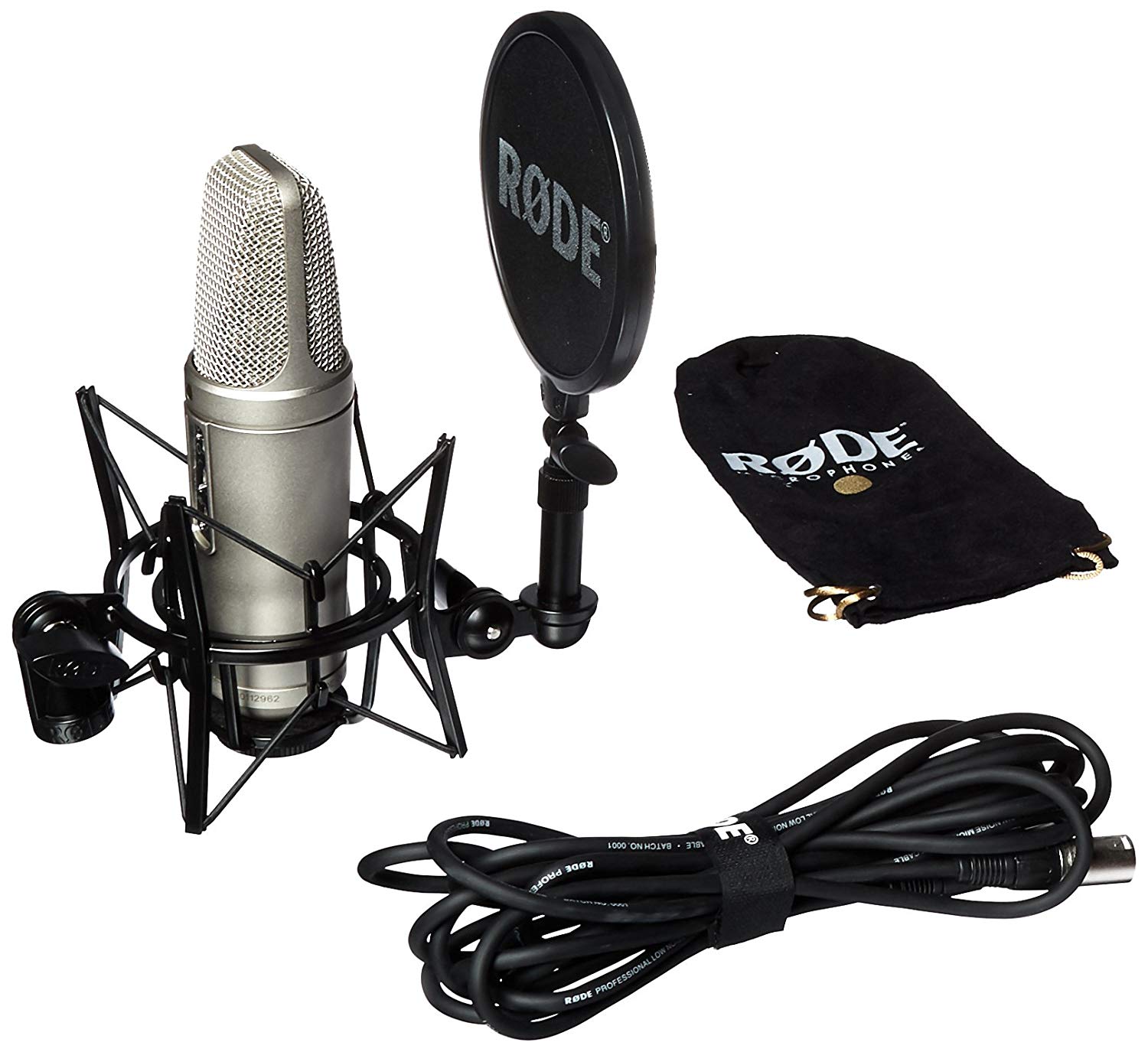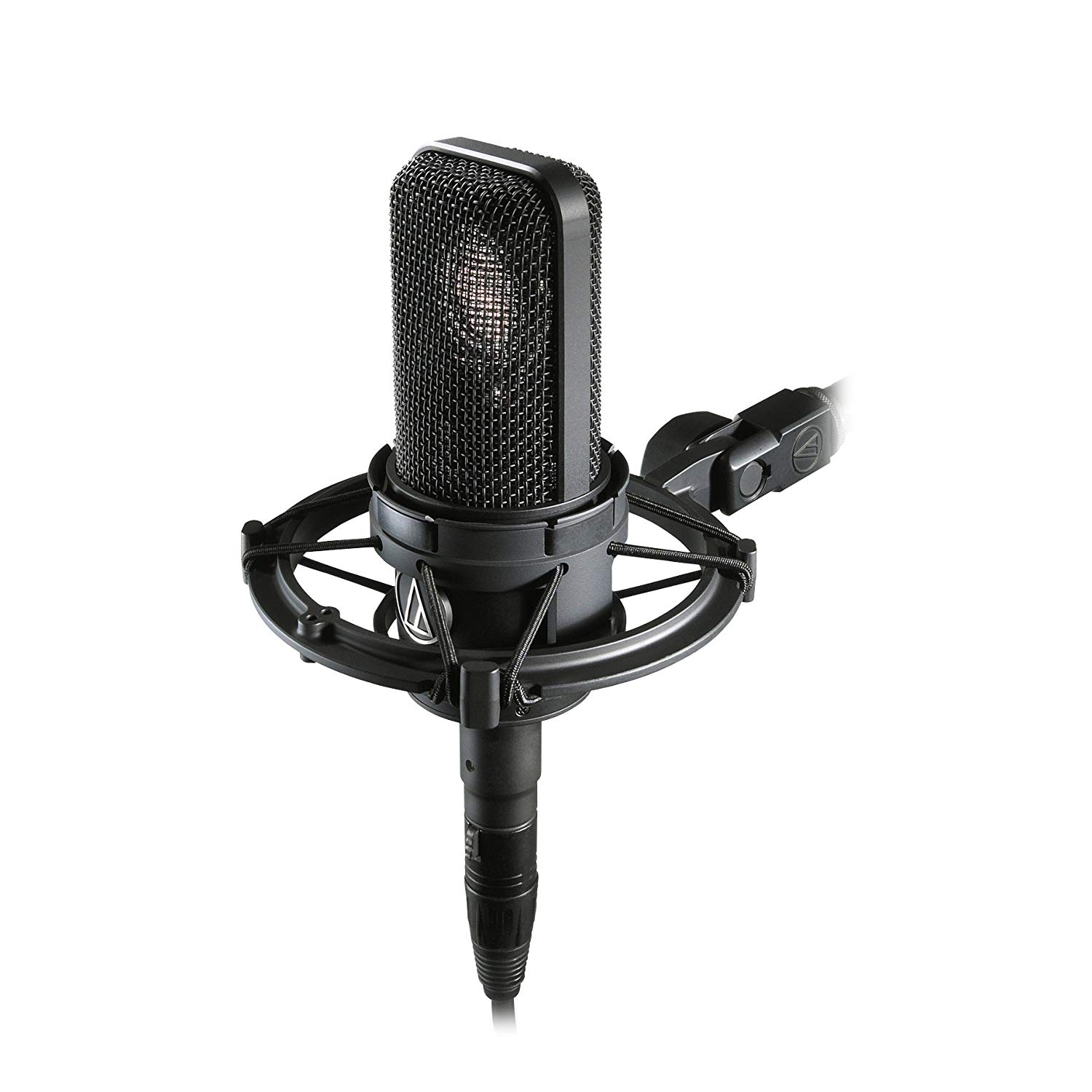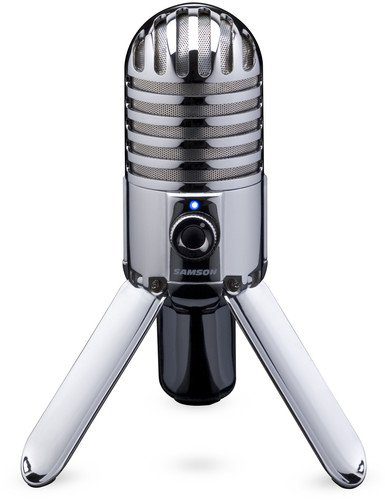Recording a voice-over is not a simple task especially if you don’t have the right microphone. Before we start, there are three criteria to think about:
1) In general, there are two common types of diaphragms – condenser and dynamic. While dynamic microphones are most suitable for the use in live concerts and other situations that require toughness and durability, condenser microphones are the most popular choice for studios.
2) The second criterion is a polar pattern. The most common choice of a polar pattern among voice artists is cardioid. You don’t need to look for omnidirectional ones or figure-8 unless you want to capture background noises from your environment.
3) Finally, think about the price. Depending on what you need, you can buy either a good enough mic for home recording or a great top-notch microphone. This list has both!
And if you want not only to record but also perform on the stage, explore our collection of best over the ear microphones.
| Product | Details |
|---|---|
|
|
|
|
|
|
1. Rode NT2A Vocal Multi-Pattern Dual Condenser Microphone
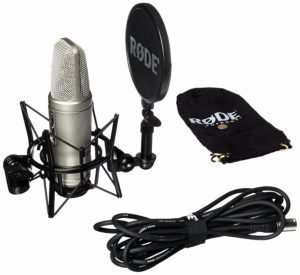
Price: $$
Rode NT2A is one of the most popular models when it comes to condenser large diaphragm mics. Its price is not the sweetest but you won’t regret buying it so, as they say, it’s worth the money.
The microphone has three regulators on it. You can switch between polar patterns and turn on (and off) the high pass filter and pad.
There are three polar patterns in this mic so we may eloquently call it multipattern, which means it suits all kinds of situations you can think of. The polar patterns are cardioid, omnidirectional, and bidirectional, or figure-8.
Each one can be applied in a number of situations. Of course, for making a voice-over, you would choose a cardioid. But who knows? Maybe you’ll face circumstances in which some other polar pattern would be the most rational choice.
Pad is used in cases when you don’t want the output to be too loud. You don’t really need to turn it on while recording voice-overs unless you are a very loud speaker. As for the high pass filter, it is made for cutting high-frequency sounds.
There are three variations of the high pass filter – flat, 40Hz, 80Hz. Try them all and by trial and error see which one is the best.
You can do well without it, of course, but having the options gives you more freedom in creating exactly what you want to create. For example, it is possible to produce a smooth ’60s sound, which can be useful if you deal with historical topics.
What Rode NT2A is great at is noise reduction. Recordings created with this mic are crisp and clear. Lastly, the microphone comes with all you need – a shock mount, a dusk cover, and a cable.
There is no need to buy additional gear. Everything comes in one package, which is extremely convenient. Having a shock mount, by the way, is a must for every voice talent regardless of whether the mic is good at noise reduction or not.
All in all, this is a very versatile mic capable of producing amazing high-quality recordings. If you are looking for the best, stop here and look no further!
Key features:
- large gold-sputtered diaphragm;
- three polar patterns;
- pad and high pass filters;
- 20 Hz – 20 000 Hz frequency response.
You may also like: 11 Best Voice Changing Microphones
2. Rode NT1-A
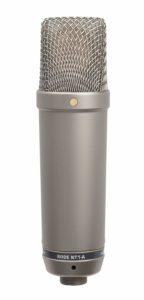
Price: $$
Rode NT1-A is less versatile than Rode NT2-A, which makes it cheaper, so if you want to save up some money, regard this option.
It doesn’t have any buttons on it like the previous model but most of the time you can do great without them.
The microphone has a large gold-sputtered diaphragm that is capable of producing warm smooth sounds. The pick-up pattern is cardioid which is what we need.
The XLR cable comes with the mic as well as a pop shield and shock mount. A couple of words about why you would prefer to buy a microphone that is connected through XLR: it is just better in terms of recording quality.
The feature that makes this mic stand out (or the one the producers are boasting about) is low self-noise.
Well, it is really so – the microphone is a high-quality one and any high-quality mic is designed so it could reduce noise. Needless to say that low self-noise is essential for good voice-over work.
Some reviews while comparing Rode NT1-A and Rode NT2A say that while the former is better for recording musical instruments, the latter perfectly suits vocalists. We don’t necessarily agree with that.
Both options can be used for a number of tasks. It all depends on specific needs and peculiarities. Well, the mic is definitely suitable for making voice-overs! Even without frequency regulation and other complicated settings, it can do a good job.
Key features:
- large gold-sputtered diaphragm;
- cardioid polar pattern;
- high SPL;
- 20 Hz – 20 000 Hz frequency response.
You may also like: Best Microphones for Voice Recordings
3. Audio Technica AT4040 large-diaphragm condenser microphone mic
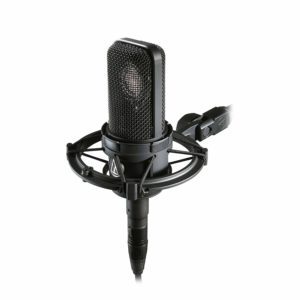
Price: $$
Audio Technica 4040 is a very stylish condenser microphone that also has a large diaphragm. Its price and characteristics are pretty much the same as the ones of Rode NT1-A.
You can check both products and compare them. Maybe at the moment when you’re going to make a purchase, one model will be cheaper than the other.
For some reason though, Rode NT1-A is considered to be better than AT4040, but sometimes it is just a matter of taste.
By the way, we recommend you check the mic before buying it at your local store just to make sure that it actually suits you. If you don’t have such an opportunity though, then, of course, you can rely on this list and the reviews of other users.
Don’t forget to read both positive and negative reviews to really get what the model is about.
Back to Audio Technica. The microphone is great at handling pressure. It comes with everything that you need in order to set up your little home studio: a shock mount and two different cases.
You might want to buy a pop filter but it is not a must. All in all, this is one more great purchase for those who want to start recording voice-overs.
Key features:
- large-diaphragm;
- cardioid polar pattern;
- stylish design;
- 20 Hz – 20 000 Hz frequency response.
4. Neumann TLM 102 MT Condenser Microphone
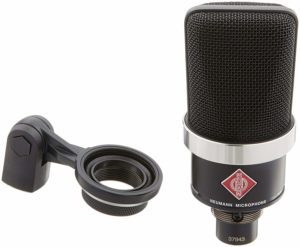
Price: $$$
Many people say something like: “Well, all those $300 mics are alright, of course, but nothing can be compared to Newmann”.
We don’t think that this is necessarily true, although Newmann does have great characteristics.
Neumann TLM 102 is quite an old model, which is why it goes under the price that is not so high. The microphone is cardioid. Like all the models on this list, it has a large diaphragm.
The size of the diaphragm and of the mic itself is not that big. The device is quite compact. By the way, it comes in two colors so you have a choice.
With all the great features and reviews, the model comes just with a shock mount to hold it on a mic stand. So if you want to use it for recording voice-overs, you’ll need to make some additional purchases.
Well, at least, it would be rational to acquire a good stable shock mount. As for the rest, a great choice!
Key features:
- large diaphragm;
- cardioid polar pattern;
- pressure gradient transducer;
- High SPL – 144dB.
5. Neumann TLM 103 Condensor Microphone
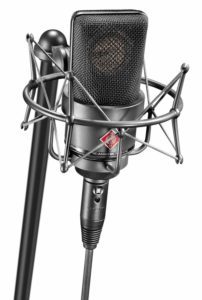
Price: $$$
Well, this one comes with a mount. Newmann TLM 103 is a golden standard for vocalists and speech artists. It has an extremely low self-noise. The capsule is cardioid. The diaphragm is large.
If you want to make recordings of really high quality and are ready to splash out for it, choose this mic. First of all, it is made to last.
And, secondly, it is made with a style. There are two colors you can choose from – satin nickel and matte black. Shock mount, by the way, is rather interesting. Any list of microphones for voice-over artists would be incomplete if it didn’t include this one!
Key features:
- large diaphragm;
- cardioid polar pattern;
- pressure gradient transducer;
- perfect quality.
6. Shure SM7B
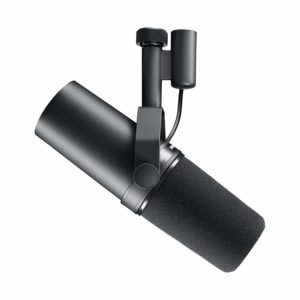
Price: $$
Shure SM7B is a dynamic microphone. Yes, most of the time dynamic microphones are not used in studios, but there are always exceptions.
Shure SM7B is a very popular model that is often used by singers. Some say that it makes the voice sound more natural and pleasant to the ear.
So, why not consider buying something like this for voice-overs as well?
Dynamic microphones are usually more durable and resistant to wear and tear. Besides, they are capable of complementing one’s voice and making it sound more pleasant than it is in reality.
For example, if you don’t usually like recordings of your voice, which most of us don’t, you can try using a dynamic mic and see the difference. Some details will be omitted but the results will still be wonderful. All in all, this is another great pro mic to consider buying!
Key features:
- dynamic diaphragm;
- cardioid polar pattern;
- great for vocals and speech;
- reliability.
You may also like: 9 Top Microphones for Public Speaking (big audience)
7. Audio-Technica AT2020 Cardioid Condenser Studio XLR Microphone
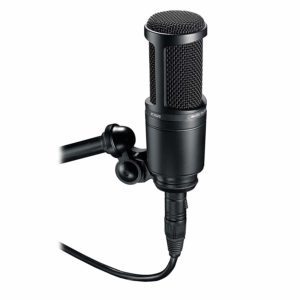
Price: $
Audio-Technica AT2020 is a very popular choice among those who are just starting out with recording.
It goes under the price that is a bit lower than one hundred dollars and yet it has a large diaphragm, a cardioid polar pattern, and an XLR input.
So, basically, all that we need in order to produce a good voice-over.
In terms of specifications, this model is worse than AT4040, but it can still do that job and this is the most important thing. The mic comes with a stand mount and a case. So if you want to use it for making voice-overs, you need to buy a proper stand.
As for the rest, many customers are overwhelmed by the quality that is available at such a cheap price. If you need something to start with, choose this model. By the way, it has a USB alternative.
Key features:
- large diaphragm;
- cardioid polar pattern;
- low price;
- 20 Hz – 20 000 Hz frequency range.
8. MXL 770 Small Diaphragm Condenser Microphone
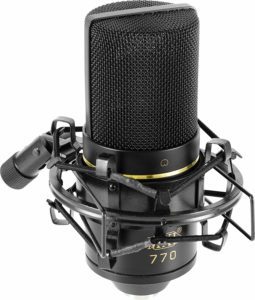
Price: $
This one is even cheaper than At2020. Originally designed for singers and musicians, it now serves voice artists and other content creators as well.
The microphone has a small diaphragm that produces sounds straight to the point. It doesn’t have that smoothness of large-diaphragm mics, but it has its own advantages.
The cardioid polar pattern ensures that only the speech that comes from the front is being recorded. The shipping case of this mic includes the case and a shock mount.
You might want to buy a pop filter as well in order to protect your recordings from plosives. All in all, this mic is kind of amazing in price-quality ratio.
Once again, if you are on the budget or don’t want to splash out, consider this option. Just beware that you’ll also need an XLR cable and an audio unit.
Key features:
- small diaphragm;
- cardioid polar pattern;
- also great for musical instruments and vocals;
- 30 Hz – 20 000 Hz frequency response.
9. Blue Microphones Yeti USB Microphone
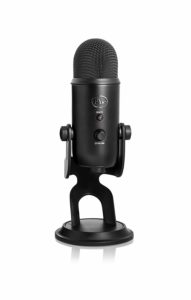
Price: $
If you don’t want to bother with buying XLR cables or audio units, you can consider USB mics.
They are usually cheaper and less problematic in terms of additional purchases. Blue Yeti is one of the most popular models on the market.
The microphone has four polar patterns to choose from – cardioid, bidirectional, stereo, and omnidirectional. By the way, the choice of colors is just as big – blackout, white, silver, platinum, red, etc.
The microphone has two buttons on it – the mute button and the one for choosing a polar pattern. Why would you need four polar patterns? Well, just in case.
For example, if there are two people making a voice-over, you can choose a bidirectional polar pattern and do the job together – less effort, and quicker results.
The most obvious advantage of all the USB mics is that they can be simply connected to your computer and that’s it! Plug and play. This microphone is a true hit. If you look for simple yet efficient options, you’ve found one.
Key features:
- USB output;
- four polar patterns;
- plug n’ play principle;
- 20 Hz – 20 000 Hz frequency response.
10. Blue Microphones Snowball Ice USB Microphone
Price: $
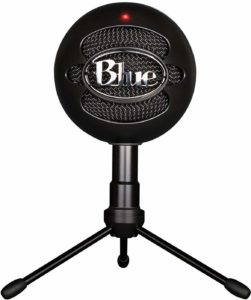
If you’re looking for even cheaper models, you can consider buying Blue Snowball. The microphone also uses a USB connection. Unlike the previous model. it has just one capsule.
The capsule is condenser and cardioid – exactly what we need! This mic is great at handling speech.
If you don’t think it is a proper choice for making voice-overs, you can at least use it for skyping and other activities of this kind.
The pop shield is included in the shipping package. There is a table stand, but if you want to use the mic with a taller stand, you can easily do it. Just make sure you have such a stand.
All in all, this is a great cheap model for beginners. By the way, you can check other Blue microphones as well. They are usually not that expensive but, as we say, can do the job. For now, take a closer look at this model.
Key features:
- cardioid polar pattern;
- USP input;
- plug n’ play;
- 40 Hz – 18 000 Hz frequency response.
11. Rode NT-USB Microphone
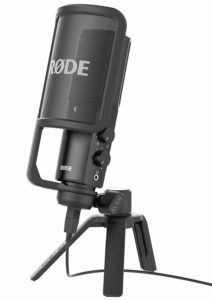
Price: $$
Rode NT must sound familiar to you if you’ve been reading carefully enough. Yes, the first two models are also Rode NT, however, they use an XLR connection while this one uses a USB one.
The microphone is not exactly cheap but since it is USB, you don’t need to buy additional equipment. Plus, well, it is relatively cheap.
As for the quality, Rode-NT is better than the previous models. The microphone has a wide frequency range. It can be used in a number of situations like singing, recording musical instruments, and, of course, making voice-overs.
At the side of the microphone, there is a headphone jack that can be used for real-time monitoring. This is a very useful feature for all kinds of recording. It is cool to have a headphone jack right in front of you.
The shipping package of this microphone includes a pop shield that you can see on the picture and a tripod stand. Basically, there is everything that you need for a successful recording of a voice-over. So, if you want both USB and quality, take a look at this model.
Key features:
- cardioid polar pattern;
- USB input;
- headphone input;
- 20 Hz – 20 000 Hz frequency response.
12. Samson Meteor Mic USB Studio Microphone
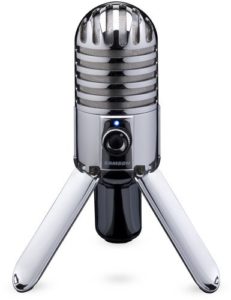
Price: $
Samson Meteor is another inexpensive microphone with a USB connection. The cool thing about it is that it has folding legs, so no stands are required.
You can just place the mic near your laptop, connect it through a USB cable and start recording.
A condenser cardioid capsule is what is needed for a proper recording of voice-overs. It provides you with a cool smooth sound which is nice to listen to.
There is also a headset output – you can connect your headset to that and listen to what you are saying in real-time.
All in all, this is a nice microphone for those who want something easy and inexpensive. There are two colors – silver and black. Choose the one you like best and wait for the delivery!
Key features:
- large diaphragm & cardioid polar pattern;
- USB input;
- headphone input;
- 20 Hz – 20 000 Hz frequency response.
Conclusion
If you are a voice talent, you probably know how difficult it is to produce good records with bad hardware. That’s why it is so vital to choose mic carefully.
Hopefully, this article has helped you to figure out what mic you need. We wish you to make a good deal and record lots of amazing voice-overs!
